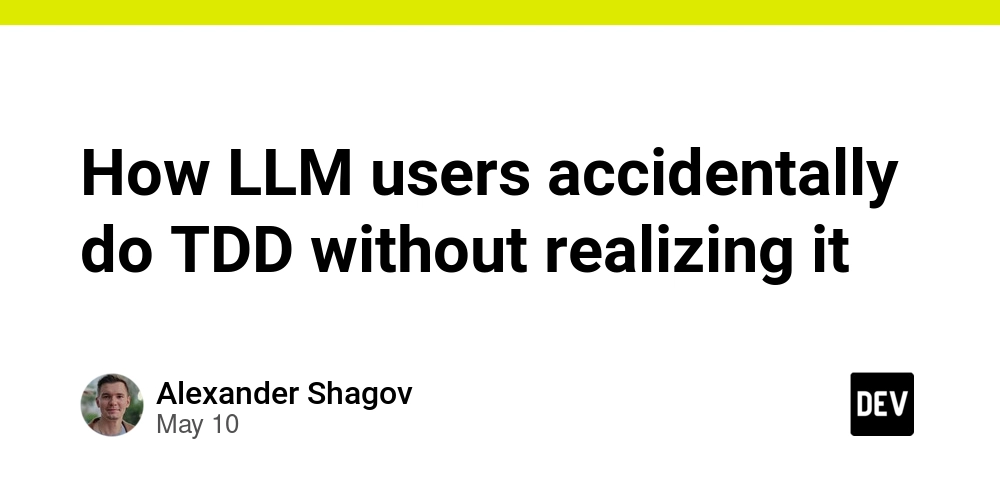How LLM users accidentally do TDD without realizing it
Most developers using LLM tools today are unknowingly following a loose version of test-driven development (TDD). 1. TDD and LLM prompting work surprisingly similar a) Start with failure TDD: You define an interface and write a failing test first. Now you know what needs fixing. LLMs: You write a vague prompt, get bad results, and think "I need to explain this better." Same basic concept. b) Make it work TDD: You write code until the test passes. LLMs: You tweak the prompt, add details, and retry until you get good output. Same iterative approach. c) Clean it up TDD: "Okay, now let's clean this up." LLMs: "This works but looks messy - needs polishing." Same final step. 2. Why developers end up doing TDD-like work with LLMs Many developers claim to hate TDD ("too much overhead!") but end up doing something similar because: They have to think through requirements first (or the AI won't help) They iterate repeatedly (just with prompts instead of tests) They refine the AI's output (which is rarely perfect on first try) 3. LLMs reveal who actually understands coding Beginners: Ask AI → Copy → Paste → Breaks → Gets stuck Experienced devs: Plan → Experiment → Debug → Verify results This mirrors TDD: Weak developers write tests that don't actually help Strong developers write tests that improve code and serve as documentation The irony If you avoid TDD but use LLMs... surprise! You're basically doing TDD-ish style of work without calling it that. TDD is structured (test → fail → code → refine) LLM prompting is more ad-hoc (ask → adjust → accept → maybe improve later) What this shows us Skilled developers use LLMs like TDD - they plan, test, and refine. Junior developers use LLMs like supercharged Stack Overflow - copy, paste, and pray. In the end, any tool just amplifies your existing thought process.

Most developers using LLM tools today are unknowingly following a loose version of test-driven development (TDD).
1. TDD and LLM prompting work surprisingly similar
a) Start with failure
- TDD: You define an interface and write a failing test first. Now you know what needs fixing.
- LLMs: You write a vague prompt, get bad results, and think "I need to explain this better." Same basic concept.
b) Make it work
- TDD: You write code until the test passes.
- LLMs: You tweak the prompt, add details, and retry until you get good output. Same iterative approach.
c) Clean it up
- TDD: "Okay, now let's clean this up."
- LLMs: "This works but looks messy - needs polishing." Same final step.
2. Why developers end up doing TDD-like work with LLMs
Many developers claim to hate TDD ("too much overhead!") but end up doing something similar because:
- They have to think through requirements first (or the AI won't help)
- They iterate repeatedly (just with prompts instead of tests)
- They refine the AI's output (which is rarely perfect on first try)
3. LLMs reveal who actually understands coding
- Beginners: Ask AI → Copy → Paste → Breaks → Gets stuck
- Experienced devs: Plan → Experiment → Debug → Verify results
This mirrors TDD:
- Weak developers write tests that don't actually help
- Strong developers write tests that improve code and serve as documentation
The irony
If you avoid TDD but use LLMs... surprise! You're basically doing TDD-ish style of work without calling it that.
- TDD is structured (test → fail → code → refine)
- LLM prompting is more ad-hoc (ask → adjust → accept → maybe improve later)
What this shows us
Skilled developers use LLMs like TDD - they plan, test, and refine.
Junior developers use LLMs like supercharged Stack Overflow - copy, paste, and pray.
In the end, any tool just amplifies your existing thought process.











































































































































































![[The AI Show Episode 146]: Rise of “AI-First” Companies, AI Job Disruption, GPT-4o Update Gets Rolled Back, How Big Consulting Firms Use AI, and Meta AI App](https://www.marketingaiinstitute.com/hubfs/ep%20146%20cover.png)



























































































































![[FREE EBOOKS] Offensive Security Using Python, Learn Computer Forensics — 2nd edition & Four More Best Selling Titles](https://www.javacodegeeks.com/wp-content/uploads/2012/12/jcg-logo.jpg)



![Ditching a Microsoft Job to Enter Startup Purgatory with Lonewolf Engineer Sam Crombie [Podcast #171]](https://cdn.hashnode.com/res/hashnode/image/upload/v1746753508177/0cd57f66-fdb0-4972-b285-1443a7db39fc.png?#)





























































































































































































































-xl.jpg)













![As Galaxy Watch prepares a major change, which smartwatch design to you prefer? [Poll]](https://i0.wp.com/9to5google.com/wp-content/uploads/sites/4/2024/07/Galaxy-Watch-Ultra-and-Apple-Watch-Ultra-1.jpg?resize=1200%2C628&quality=82&strip=all&ssl=1)












![Beats Studio Buds + On Sale for $99.95 [Lowest Price Ever]](https://www.iclarified.com/images/news/96983/96983/96983-640.jpg)

![New iPad 11 (A16) On Sale for Just $277.78! [Lowest Price Ever]](https://www.iclarified.com/images/news/97273/97273/97273-640.jpg)








































![Apple's 11th Gen iPad Drops to New Low Price of $277.78 on Amazon [Updated]](https://images.macrumors.com/t/yQCVe42SNCzUyF04yj1XYLHG5FM=/2500x/article-new/2025/03/11th-gen-ipad-orange.jpeg)



![[Exclusive] Infinix GT DynaVue: a Prototype that could change everything!](https://www.gizchina.com/wp-content/uploads/images/2025/05/Screen-Shot-2025-05-10-at-16.07.40-PM-copy.png)






![T-Mobile discontinues a free number feature but a paid alternative exists [UPDATED]](https://m-cdn.phonearena.com/images/article/170235-two/T-Mobile-discontinues-a-free-number-feature-but-a-paid-alternative-exists-UPDATED.jpg?#)

















































